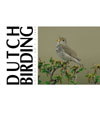Dutch Birding volume 27 (2005) no 5

Pine Grosbeaks in the Netherlands in November 2004
In November 2004, at least four Pine Grosbeaks Pinicola enucleator were seen in the northern part of Netherlands. The first was a first-winter male found injured under a window in an urban area at Leeuwarden, Friesland, and taken into care on 15 November; it died the next day. On 16 November, an adult male and probably an adult female (first-winter not excluded) were discovered late in the afternoon in a suburban area in Groningen, Groningen. These birds were still present the next morning and attracted numerous birders and photographers, also from abroad, during their five-day stay until 20 November. On 16 and 17 and again on 20 November, probably a first-winter male (female not excluded) was photographed by two independent observers (non-birders) at Alkmaar, Noord-Holland. Although the photographs show some differences, it was concluded that there was insufficient evidence to accept these sightings as relating to more than one individual (both localities are only a few 100 m apart). The 2004 invasion in the Netherlands therefore concerns at least four individuals. In addition, five individuals were claimed but not photographed in November (three), December (one) and February 2005 (one); these reports were rejected by the Dutch rarities committee (CDNA) because of insufficient (or lack of) documentation.
There are four previous records, all in the south-western part of the country: at Rotterdam, Zuid-Holland, on 5 December 1909, 8 December 1909 and early November 1928 (the latter was taken into care and died in May 1931) and at Melissant, Zuid-Holland, on 24 March 1996 (an adult male photographed). The birds in Groningen in November 2004 were the first to be twitchable. Although the identification of the four in 2004 was straightforward, the species is notoriously difficult to sex and age other than in adult male plumage. The bird from Leeuwarden was accepted as a first-winter male on basis of the pointed tail-feathers and deep orange coloration on head and breast. The female-type in Groningen was presumably an adult female, based on the more rounded (but still slightly pointed) tail-feathers and 'clean' white edges to the flight-feathers, but a first-winter male or female can probably not be excluded with certainty. The female-type from Alkmaar was not documented well enough to be sexed and/or aged.
An overview is given of Pine Grosbeak movements in Scandinavia (Denmark, Norway and Sweden) in autumn 2004. The invasion brought not only large numbers to southern Norway and the southern half of Sweden in October-December but also 35 individuals to Denmark and one to North Yorkshire, England, on 8-10 November. There was one report in Estonia on 19 November and one (of three birds) in northern Germany on 7 November (these reports have to be considered by the relevant rarities committees).
In Denmark, the largest movement of 13 individuals was noted on 14 November; in total, 29 were seen between 7 and 19 November, all in Nordjylland and Sjælland. These dates coincide with the arrival of at least four birds in the Netherlands on 15-16 November indicating that this was the peak period of the southward movements in the 2004 invasion.
Jacob G Bosma, Bekemaheerd 116, 9737 PX Groningen, Nederland (jacobbosmatiscali.nl)
A (Bert) de Bruin, Padangstraat 35a, 9715 CL Groningen, Nederland (tetewxs.nl)
Enno B Ebels, Joseph Haydnlaan 4, 3533 AE Utrecht, Nederland (ebelswxs.nl)
terug






